General Mills Bundle
Can General Mills Maintain Its Reign in the Evolving Food Industry?
General Mills, a titan in the global food industry since 1928, is constantly refining its growth strategy to stay ahead. From its humble beginnings as the Minneapolis Milling Company, the company has evolved into a powerhouse with iconic brands like Cheerios and Häagen-Dazs. Their journey reflects a commitment to strategic adaptation and consumer-focused innovation, balancing legacy with modern challenges.
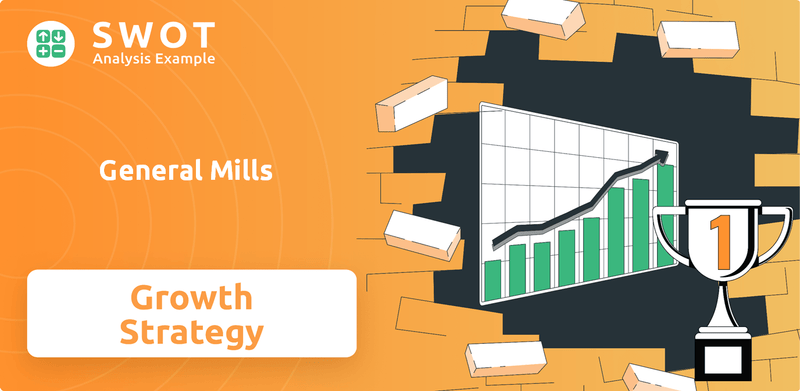
This deep dive into General Mills will explore how they plan to achieve future growth, including detailed expansion initiatives and a robust innovation strategy. We'll analyze their financial outlook, assess potential risks, and examine General Mills SWOT Analysis to understand their competitive position. The analysis will cover key aspects of General Mills' future prospects, including food industry trends, consumer packaged goods, and General Mills' financial performance, providing actionable insights for investors and industry watchers alike.
How Is General Mills Expanding Its Reach?
The growth strategy of General Mills is focused on expanding its market presence and enhancing its product portfolio. This involves strategic acquisitions, particularly in the pet food sector, and a focus on core markets and global platforms.
The company's approach is driven by its Accelerate strategy, which emphasizes sustainable and profitable growth. This strategy guides the company's decisions in acquisitions, divestitures, and product innovation.
General Mills' future prospects are closely tied to its ability to adapt to changing consumer preferences and market trends. The company's financial performance is also a key factor in its expansion initiatives.
General Mills has been actively acquiring pet food brands to strengthen its position in this growing market. These acquisitions include Blue Buffalo, Nudges, Top Chews, True Chews, Fera Pets, and Edgard & Cooper. In November 2024, the company announced the acquisition of Whitebridge Pet Brands' North American premium cat feeding and pet treating business for $1.45 billion.
The Accelerate strategy guides General Mills' growth initiatives, focusing on core markets, global platforms, and local gem brands. This strategy aims to achieve sustainable and profitable growth through strategic investments and portfolio management. The company is also driving growth through product innovation and brand building.
General Mills is reshaping its portfolio through divestitures to increase its underlying growth exposure. In the third quarter of fiscal 2025, the company divested its Canada yogurt business. In September 2024, it agreed to sell several yogurt brands in the United States and Canada. These changes aim to optimize the portfolio for future growth.
General Mills is investing in product innovation and brand building to drive growth. The company increased its media investment by nearly 40% from fiscal 2019 to fiscal 2024, with another increase expected in fiscal 2025. New product launches are planned for fiscal 2026, including new varieties of Cheerios and investments in refrigerated dough.
General Mills' expansion initiatives, particularly in the pet food category, are expected to have a significant financial impact. The acquisition of Whitebridge Pet Brands is expected to close in the third quarter of fiscal 2025.
- The pet food category, led by the Blue Buffalo brand, is projected to surpass $2 billion in annual revenue by 2025.
- The acquisition of Whitebridge Pet Brands is expected to strengthen General Mills' position in the growing cat feeding and treats segments, which collectively represent a $24 billion retail sales market within the broader $52 billion U.S. pet food category.
- The company expects to use the net proceeds from the yogurt divestiture for share repurchases, but also noted that the funds could be used for further acquisitions.
- Investments in refrigerated dough have led to a 10% increase in pound volume in the third quarter of fiscal 2025.
General Mills SWOT Analysis
- Complete SWOT Breakdown
- Fully Customizable
- Editable in Excel & Word
- Professional Formatting
- Investor-Ready Format
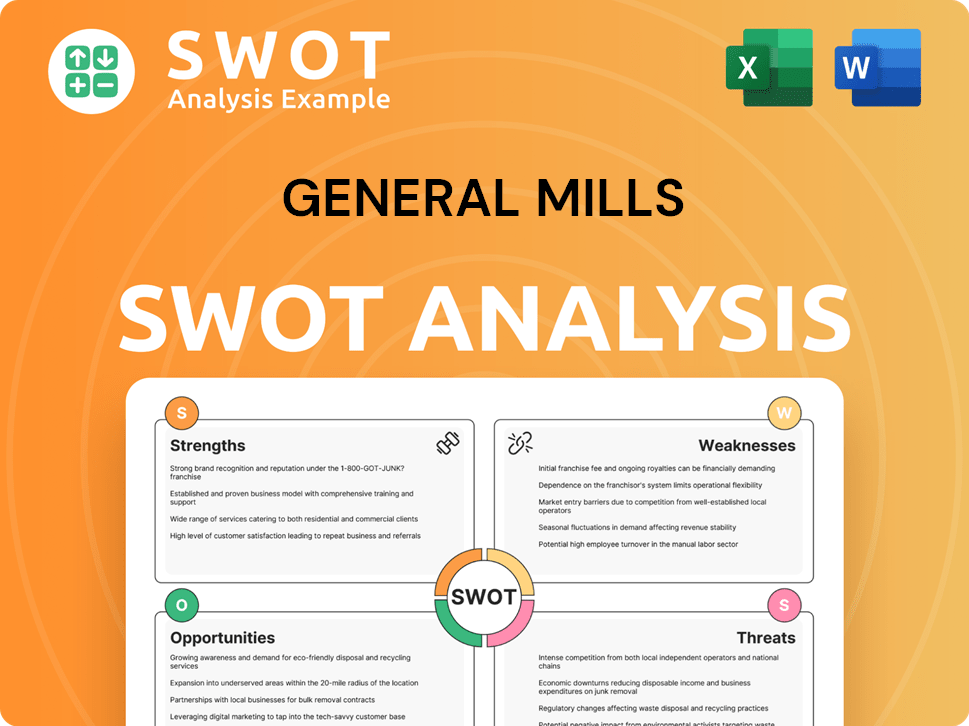
How Does General Mills Invest in Innovation?
The company's growth strategy is heavily influenced by its ability to understand and respond to evolving consumer needs. This includes adapting to changing dietary preferences, such as the increasing demand for healthier and more sustainable food options. The company also focuses on leveraging data analytics to gain insights into consumer behavior, enabling more effective product development and marketing strategies.
General Mills' future prospects are closely tied to its capacity to innovate and embrace technological advancements. This involves not only creating new products but also optimizing its operations and supply chain through digital transformation. The company's ability to navigate the dynamic food industry trends and maintain a competitive edge will be crucial for its long-term success.
The company's strategic focus on innovation and technology is designed to drive sustained growth and enhance operational efficiency. General Mills has significantly increased its investment in digital technologies, data analytics, and AI to optimize various aspects of its business, from supply chain management to marketing efforts. This commitment is a key element of the company's overall growth strategy.
Since 2019, the company has doubled its investment in digital, data, and technology. This investment is aimed at building a robust digital infrastructure to support its growth initiatives.
General Mills is leveraging artificial intelligence (AI) and machine learning to improve efficiency and optimize its operations. AI projects have already resulted in significant cost savings.
AI models are used to assess over 5,000 daily shipments, leading to reduced transportation costs. This has resulted in over $20 million in savings since fiscal year 2024.
Real-time performance data in manufacturing is expected to lead to over $50 million in waste reduction in fiscal year 2025. This highlights the company's commitment to operational efficiency.
The company uses precision marketing strategies, utilizing consumer data to personalize content and product recommendations. This approach enhances customer engagement and drives sales.
General Mills has a robust innovation pipeline, with new product launches planned for fiscal 2026. The company's innovation efforts are a key driver of its growth.
The company's innovation strategy extends beyond new products, encompassing platform development and expansion into new segments. Sustainability is also a core focus, with significant initiatives underway.
- New Products: In fiscal 2024, General Mills launched the five largest new products in the U.S. Cereal category. Successful new varieties were also introduced in the Pet segment.
- Regenerative Agriculture: The company is committed to advancing regenerative agricultural practices on one million acres of land by 2030, with 600,000 acres already engaged. This supports sustainable sourcing and environmental stewardship.
- Climate Transition Action Plan: General Mills aims to cut greenhouse gas emissions by 30% from 2020 levels by 2030. This includes shifting freight from trucks to rail and eliminating deforestation from its supply chains by 2025.
- Trusted Advisor Partnership (TAP): General Mills supports the TAP program, which aims to expand regenerative agriculture in Canada by training crop advisors. The first Canadian cohort launched in early 2025.
For more insights into the financial aspects and ownership structure of the company, you can refer to the article about Owners & Shareholders of General Mills.
General Mills PESTLE Analysis
- Covers All 6 PESTLE Categories
- No Research Needed – Save Hours of Work
- Built by Experts, Trusted by Consultants
- Instant Download, Ready to Use
- 100% Editable, Fully Customizable
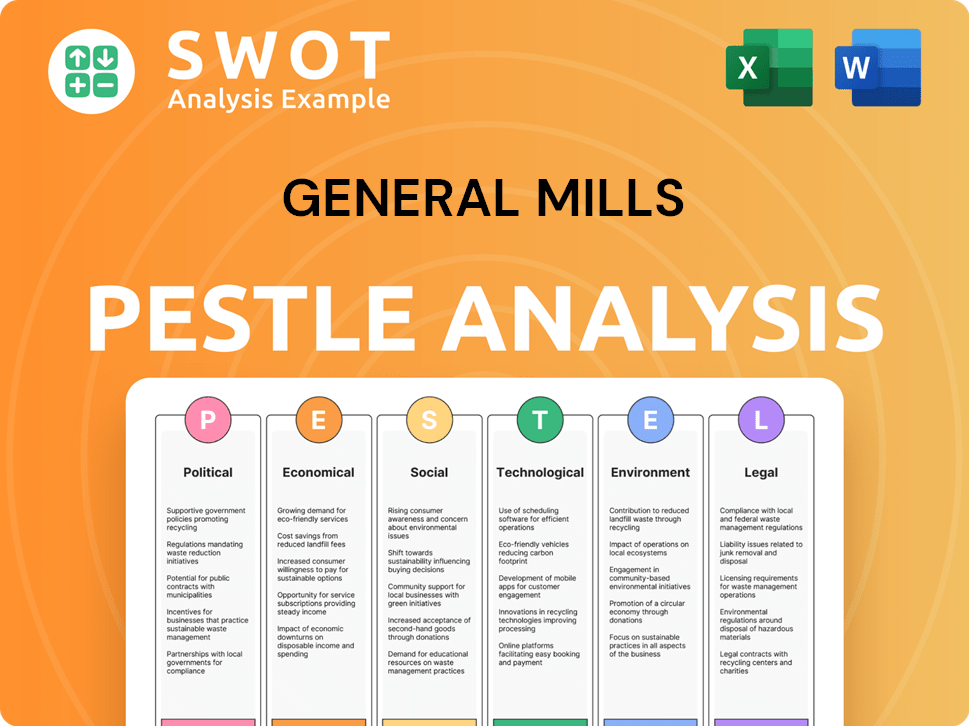
What Is General Mills’s Growth Forecast?
The financial outlook for General Mills in fiscal year 2025 is shaped by a strategic focus on accelerating organic net sales growth. This involves investments in 'remarkable experiences' across its leading food brands, aiming to boost household penetration and improve market share. The company anticipates a gradual improvement in volume trends within its categories, although overall category dollar growth is expected to be below long-term projections.
In the second quarter of fiscal 2025, General Mills reported a 2% increase in net sales, reaching $5.2 billion, with organic net sales up 1%. Operating profit surged 33% to $1.1 billion, and adjusted operating profit increased 7% in constant currency. These results, however, included certain timing benefits expected to reverse in the second half of fiscal 2025.
General Mills has updated its full-year fiscal 2025 financial targets, reflecting increased investment in promotional activities and brand building. The company now expects organic net sales to be at the lower end of its previously projected range of flat to up 1%. Adjusted operating profit is now anticipated to decrease between 2% and 4% in constant currency, a revision from the earlier forecast of a 2% decline to flat. Similarly, adjusted diluted EPS is projected to decline between 3% and 1% in constant currency, a shift from the previous forecast of a 1% decrease to a 1% increase. These investments, while impacting the fiscal 2025 profit outlook, are intended to position General Mills for sustainable growth in fiscal 2026 and beyond.
General Mills is prioritizing investments in promotional activities and brand building to drive future growth. These investments are expected to impact the short-term profit outlook but are crucial for long-term sustainability. The company aims to deliver 'remarkable experiences' to enhance its leading food brands.
In fiscal 2024, net sales were $19.9 billion, with adjusted operating profit up 4% in constant currency to $3.6 billion. Adjusted diluted EPS increased by 6% to $4.52. The company returned over $3 billion to shareholders through dividends and share repurchases.
General Mills is leveraging Holistic Margin Management (HMM) to achieve cost savings, expecting at least 5% savings from the cost of goods sold in fiscal 2025 and 2026. A new cost-control initiative is projected to yield an additional $100 million or more in savings. Free cash flow conversion is expected to be at least 95% of adjusted after-tax earnings in fiscal 2025.
Through the first six months of fiscal 2025, General Mills achieved 1% growth in organic pound volume, a significant improvement compared to its fiscal 2024 performance. This indicates positive trends in consumer demand and the effectiveness of the company's strategies.
General Mills has a strong track record of returning value to shareholders. In fiscal 2024, the company returned over $3 billion through dividends and share repurchases. Since fiscal 2021, the total return to shareholders has reached nearly $10 billion.
The company's focus on accelerating organic net sales growth and strategic investments positions it for sustained growth. General Mills' growth strategy is detailed further in the Marketing Strategy of General Mills.
General Mills Business Model Canvas
- Complete 9-Block Business Model Canvas
- Effortlessly Communicate Your Business Strategy
- Investor-Ready BMC Format
- 100% Editable and Customizable
- Clear and Structured Layout
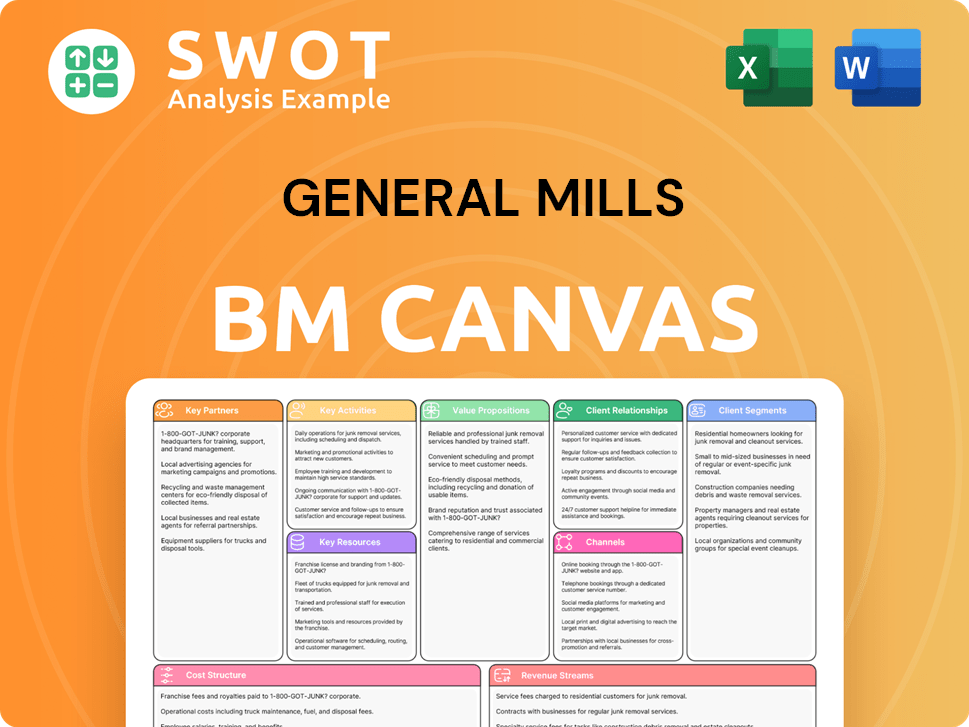
What Risks Could Slow General Mills’s Growth?
General Mills navigates a complex landscape of potential risks and obstacles that could affect its growth. These challenges span competitive pressures, economic uncertainties, and shifts in consumer behavior. Successfully managing these risks is crucial for the company's long-term financial health and its ability to capitalize on opportunities within the consumer packaged goods sector.
A primary concern is the intense competition within the food industry, including the rising influence of private label brands. This competition can squeeze profit margins and demand increased marketing investment. Additionally, the company must contend with regulatory changes and evolving consumer preferences, which require constant adaptation and innovation to maintain market relevance and drive Mission, Vision & Core Values of General Mills.
The company faces significant risks related to cost inflation and commodity price volatility, impacting the cost of raw materials, energy, and logistics. Supply chain disruptions and the need for operational resilience remain critical concerns. The consumer environment continues to be uncertain, with consumers exhibiting prolonged value-seeking behaviors, which presents challenges to delivering organic sales growth in the short term.
The food industry is highly competitive, with General Mills facing pressure from private label brands. This competition can erode market share and require increased promotional spending.
Rising costs for raw materials, energy, and logistics pose a significant risk. These factors can squeeze profit margins and require effective cost management strategies.
Evolving consumer preferences and health trends challenge General Mills' reliance on categories like cereal and snacks. Adapting to these changes requires innovation and portfolio transformation.
Regulatory changes related to food safety and labeling create compliance challenges. Staying compliant requires ongoing investment and adaptation to new standards.
Economic downturns can lead to value-seeking behaviors among consumers, impacting sales. Consumer confidence indices in early 2025 were similar to 2008 levels, indicating a difficult situation for consumers.
Transforming the portfolio to meet evolving health and wellness trends carries execution risks. Successful transformation requires effective innovation and market strategies.
General Mills is diversifying its portfolio, including significant investments in the pet food segment. This strategy helps to mitigate risks associated with over-reliance on specific food categories and provides new growth opportunities.
The company employs risk management frameworks and scenario planning to anticipate and address potential challenges. This proactive approach helps to build resilience and adaptability within the company.
General Mills focuses on driving cost savings through initiatives like Holistic Margin Management (HMM). HMM is expected to reduce the cost of goods sold by at least 5% in fiscal 2025 and fiscal 2026, freeing up resources for reinvestment in growth.
Incremental investments in brand building and innovation are made to strengthen offerings. These investments, although they may lower the profit outlook for fiscal 2025, are considered crucial for sustainable growth in fiscal 2026 and beyond.
General Mills Porter's Five Forces Analysis
- Covers All 5 Competitive Forces in Detail
- Structured for Consultants, Students, and Founders
- 100% Editable in Microsoft Word & Excel
- Instant Digital Download – Use Immediately
- Compatible with Mac & PC – Fully Unlocked
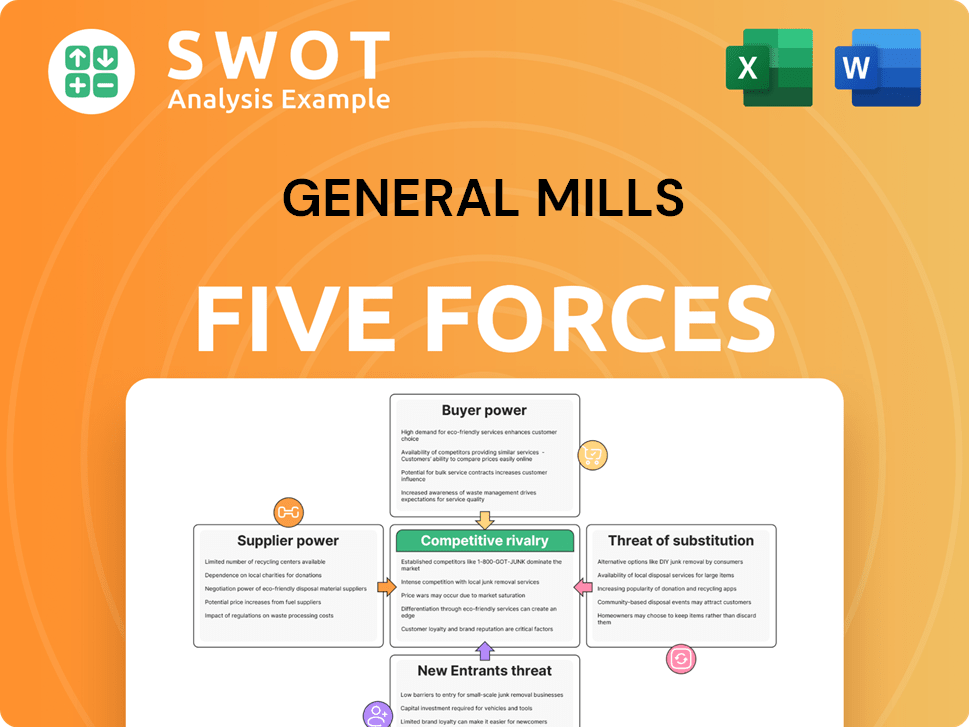
Related Blogs
- What are Mission Vision & Core Values of General Mills Company?
- What is Competitive Landscape of General Mills Company?
- How Does General Mills Company Work?
- What is Sales and Marketing Strategy of General Mills Company?
- What is Brief History of General Mills Company?
- Who Owns General Mills Company?
- What is Customer Demographics and Target Market of General Mills Company?
Disclaimer
All information, articles, and product details provided on this website are for general informational and educational purposes only. We do not claim any ownership over, nor do we intend to infringe upon, any trademarks, copyrights, logos, brand names, or other intellectual property mentioned or depicted on this site. Such intellectual property remains the property of its respective owners, and any references here are made solely for identification or informational purposes, without implying any affiliation, endorsement, or partnership.
We make no representations or warranties, express or implied, regarding the accuracy, completeness, or suitability of any content or products presented. Nothing on this website should be construed as legal, tax, investment, financial, medical, or other professional advice. In addition, no part of this site—including articles or product references—constitutes a solicitation, recommendation, endorsement, advertisement, or offer to buy or sell any securities, franchises, or other financial instruments, particularly in jurisdictions where such activity would be unlawful.
All content is of a general nature and may not address the specific circumstances of any individual or entity. It is not a substitute for professional advice or services. Any actions you take based on the information provided here are strictly at your own risk. You accept full responsibility for any decisions or outcomes arising from your use of this website and agree to release us from any liability in connection with your use of, or reliance upon, the content or products found herein.